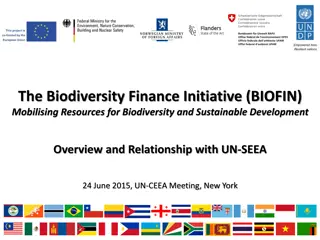Exploring Algae: Biodiversity, Importance, and Habitats
Delve into the world of algae with Professor Olubukunola O. Oyesiku as he discusses the classification, economic importance, natural habitats, and ecological contributions of algae. Learn about the unique features that distinguish algae from other plants and explore their fossil record dating back 1.5 billion years.
Download Presentation

Please find below an Image/Link to download the presentation.
The content on the website is provided AS IS for your information and personal use only. It may not be sold, licensed, or shared on other websites without obtaining consent from the author. Download presentation by click this link. If you encounter any issues during the download, it is possible that the publisher has removed the file from their server.
E N D
Presentation Transcript
BIO102 BIO102 GENERAL BIOLOGY II GENERAL BIOLOGY II 6 October 2024 Prof. Olubukunola O. OYESIKU (Bup) 1
ALGAE ALGAE 6 October 2024 BIO102 2
In our todays discussion, students will be taken to the next level of understanding biodiversity with particular reference to algae 6 October 2024 Prof. Olubukunola O. OYESIKU (Bup) 3
Overview of Algae Algae belong to the kingdom Protista They grow everywhere in the world 6 October 2024 BIO102 4
Algae are earlier autotrophic protists They have unique metabolic process They produced and released the first O2 to the world 6 October 2024 Prof. Olubukunola O. OYESIKU (Bup) 5
They occur in forest and urban areas: 1. Water body 2. waterlogged and moist soils 3. trees, metals and sculpture in moist to wet conditions BIO102 6 October 2024 6
Objectives: The objective of study of algae are to: 1. classify common forms of algae 2. list economic importance of algae 3. identify the natural habitats of algae 4. evaluate ecological contribution of algae to ecosystems 5. state features distinguishing algae from all other plants 6 October 2024 Prof. Olubukunola O. OYESIKU (Bup) 7
Learning Outcome: Students should be able to: 1. classify five common forms of algae 2. list ten economic importance of algae 3. identify five natural habitats of algae 4. evaluate ten ecological contribution of algae to ecosystems 5. state five features distinguishing algae from all other plants 6 October 2024 BIO102 8
Fossil Record All algae are eukaryotes 1. Fossil and chemical evidences showed that algae are eukaryotes 2. They appeared in the fossil record1.5 billion years ago (BYA) 6 October 2024 Prof. Olubukunola O. OYESIKU (Bup) 9
Forms of Algae 1. Microalgae 2. Macroalgae 6 October 2024 BIO102 10
Microalgae form a larger % of the world population of algae Examples 1. Scenedesmus 2. Desmids 3. Euglena Unicellular forms : 6 October 2024 Prof. Olubukunola O. OYESIKU (Bup) 11
Macroalgae are multicellular like higher plants But have false roots, stem and leaves 6 October 2024 BIO102 12
Examples: 1. Brown algae (Phaeophyta) 2. Green algae (Chlorophyta) 3. Red algae (Rhodophyta) Multicellular form: 6 October 2024 Prof. Olubukunola O. OYESIKU (Bup) 13
Knowledge gained in this course makes you more conscious of algae: 1. abundance 2. diversity 3. ecological roles 6 October 2024 BIO102 14
Especially, for those going to major in Phycology/Algology As well as those needing the knowledge in their various field of studies 6 October 2024 Prof. Olubukunola O. OYESIKU (Bup) 15
Download: Visit: oyesiku.olubukunola@oou agoiwoye.edu.ng 6 October 2024 BIO102 16
Biology of Algae Algology (Phycology) is the study of algae (Latin word for seaweed ) 6 October 2024 Prof. Olubukunola O. OYESIKU (Bup) 17
Algae are primary producers: 1. Trap solar energy directly from atmosphere 2. Convert solar energy to carbohydrates (CHO) 3. Resources in aquatic and terrestrial food chains/webs 6 October 2024 BIO102 18
Facts about Algae 1. Positive impacts 2. Negative impacts 6 October 2024 Prof. Olubukunola O. OYESIKU (Bup) 19
Positive impacts of Algae on Environment 1. Synthesis of simple minerals into complex organic matter (COM) 2. Products (COM) recycles via microbes to form simple elements 3. Produce 80% of the world s food supply either directly or indirectly 4. Produce more oxygen (75%) than all the plants in the world 5. source of food for many aquatic animals: (From tiny shrimps to the mighty Whales) 6 October 2024 BIO102 20
Negative impacts of Algae on Environment 1. Metabolism produce unpleasant water and soil odors 2. Alga bloom caused by high levels of phosphorous and nitrate in water 3. Algal bloom (green murky/cloudy) change colour of water 4. Alga bloom cause mass mortality of higher organisms 5. Bacteria bloom change the H2O colour to cloudy white 6 October 2024 Prof. Olubukunola O. OYESIKU (Bup) 21
Mechanism of Algal bloom production 1. in the presence of high levels of phosphorous and nitrate in water 2. direct sunlight breakdown floating mechanism of algae 3. high death of algae turn the water body murky green (algal bloom) 4. bloom causes O2 insufficiency and led to high death of other organisms 5. algae compete with bacteria to consume oxygen 6 October 2024 BIO102 22
Reproduction in Algae Unlike bacteria, algae reproduce by: 1. mitosis (asexual, vegetative and fragmentation) 2. Meiosis (sexual) 6 October 2024 Prof. Olubukunola O. OYESIKU (Bup) 23
Asexual Reproduction in Algae Major mode of reproduction is by cell division or simple: 1. fragmentation of colonial or filamentous forms 2. spores formation by mitosis Example: Chlamydomonas 6 October 2024 BIO102 24
Asexual Process: Stage 1: cell s flagella degenerate and drop off Stage 2: mitotic (n) division of nucleus and then Stage 3: pair of n developed into two daughter cells Stage 4: daughter cells form colony in nutrient rich body of water Stage 5: daughter cells develop flagella and escape from the colony in nutrient poor water Stage 6: process is repeated in multiples of 2 (2, 4, 8, 16 n) 6 October 2024 Prof. Olubukunola O. OYESIKU (Bup) 25
Consequence of asexual method All cells remain haploid Fix number of chromosomes in the nucleus Diversity not favored by asexual means in Chlamydomonas Example: Chlamydomonas 6 October 2024 BIO102 26
Sexual Reproduction in Algae Sexual forms include alternation of generations of haploid and diploid phases Two phases of sexual reproduction 1. Gametophyte (n) 2. Sporophyte (2n) 6 October 2024 Prof. Olubukunola O. OYESIKU (Bup) 27
Phase Dominance Algae Dominant phase Sargassum Sporophyte Ectocarpus Both sporophyte and gametophyte Spirogyra gametophyte 6 October 2024 BIO102 28
Sexual Process Under favorable conditions: Stage 1: cells (zoospores) in pairs lock by their flagella as gametes (A) Stage 2: cell walls break down and the protoplasts mate and fused together (B) Stage 3: diploid zygote formed (C) Stage 4: zygote undergoes meiosis (D) Stage 5: producing four haploid zoospores (E) Stage 6: zygote wall breaks down to release zoospores (E) Stage 7: grow to adult Chlamydomonas cells (Fig 1.1) 29 6 October 2024 Prof. Olubukunola O. OYESIKU (Bup)
6 October 2024 BIO102 30
Consequence of sexual method Doubled number of chromosomes (n to 2n) in nucleus of zygote and sporophyte Diversity is favored by sexual method Environmental factors (temp. salinity, nutrient, day length) limit sexual method 6 October 2024 Prof. Olubukunola O. OYESIKU (Bup) 31
Classification of algae based on nutritional modes: 1. chemotrophic 2. heterotrophic 3. mixotrophic 4. phototrophic 6 October 2024 BIO102 32
Chemotrophic mode Algae ingest and digest chemicals (organic/inorganic) for their nutritional need Chemotroph behaves as organotroph in habitat rich in organic molecules Chemotroph behaves as lithotroph in habitat rich in inorganic molecules 6 October 2024 Prof. Olubukunola O. OYESIKU (Bup) 33
Heterotrophic mode Algae behaves as heterotroph They convert decaying organic matter into chemical energy BIO102 6 October 2024 34
Mixotrophic mode Algae may behave as mixotroph They use both light energy and organic carbon to obtain their energy Prof. Olubukunola O. OYESIKU (Bup) 6 October 2024 35
Example: Dinoflagellates Based on prevailing conditions Dinoflagellates exist as either: 1. autotroph or 2. heterotroph BIO102 6 October 2024 36
Features of Algae 1. All true algae are eukaryotes like all other higher plants 2. All true algae have a nucleus and plastids enclosed in a membrane 6 October 2024 Prof. Olubukunola O. OYESIKU (Bup) 37
3. Most algae are phototrophic while a few are chemotrophic mixotrophic 4. They photosynthesize and produce oxygen as byproduct except for a few 6 October 2024 BIO102 38
Example: Chlamydomonas Chlamydomonas produces oxygen and hydrogen answerable to prevailing temperature of its habitat 6 October 2024 Prof. Olubukunola O. OYESIKU (Bup) 39
Morphology of Algae Algae can be grouped into several forms: 1. reproductive cells 2. pigments and food reserves 3. unicellular and 4. multicellular algae 6 October 2024 BIO102 40
Unicellular algae forms 1. colony of small spherical motile cells (Volvox) 2. single non-motile cells with cell walls(Coccoid) 3. individuals of non-motile cells in mucilage envelope (Capsoid) 4. palm-like non-motile cells in mucilage envelope (Palmelloid) 6 October 2024 Prof. Olubukunola O. OYESIKU (Bup) 41
5. branch of string of non-motile cells (Heterotrichous) 6. string of non-motile cells connected straight or branch in one plane (Filamentous) 7. cells forming thallus with simple differentiation (Parenchymatous) 8. plant body lacking cross walls (Siphonaceous) 9. cells with basal mucilage stalk (Dendroid) 6 October 2024 BIO102 42
Multicellular algae forms Multicellular algae grow under the sea with roots attached to the sea bed and a few exceeding 50 m in length Examples 1. green algae 2. red algae 3. brown algae Exception: Floating brown algae, Sargassum natans and S. fluitans 6 October 2024 Prof. Olubukunola O. OYESIKU (Bup) 43
6 October 2024 BIO102 44
Habitats of Algae Major habitats of the world algae 1. Terrestrial 2. Fresh water and 3. Marine 6 October 2024 Prof. Olubukunola O. OYESIKU (Bup) 45
Terrestrial Habitats Diversity 1. infusion (dried bryophyte or grasses) 2. animal fecal (snails, worms, crustacean) 3. waterlogged ground (marshes, swamps, mud, sand) 4. rough surfaces in in shady moist and humid conditions : (trees, rocks, sculptures, glass and metals) 6 October 2024 BIO102 46
5. roots of submerge water plants(ferns, lotus, lettuce) 6. lagoon (abundant desmids, diatoms) 7. Litter scum (river, stream, fish ponds, water reservoirs) 8. Salty lagoon (brackish water) 9. Salty lakes and marshes 10. Open Ocean 6 October 2024 Prof. Olubukunola O. OYESIKU (Bup) 47
Ecology of Algae Algae are important keystone at the base of ecological food chain/web Almost all living organisms feed on algae Marine algae produced about 50% O2 6 October 2024 BIO102 48
Ecology of Algae They fix atmospheric nitrogen They share metabolic trait with purple non- sulphur bacteria (Halobacteria) but differs from all bacteria 6 October 2024 Prof. Olubukunola O. OYESIKU (Bup) 49
Economic uses of Algae New technology: algae as source of heat and electricity generation 1. Alternative to fossil fuel (alga fuel) 2. Commercially grown oil-producing algae in high salinity ponds (oleaginous microalgae) 50 6 October 2024 BIO102























